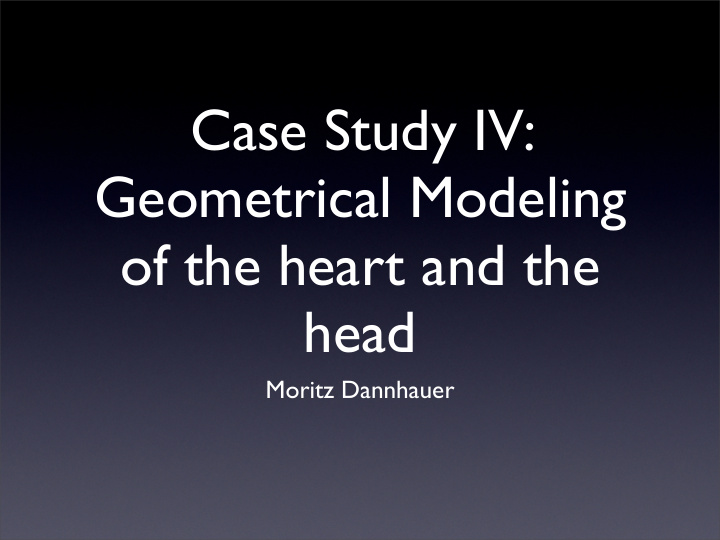



Case Study IV: Geometrical Modeling of the heart and the head Moritz Dannhauer
Motivation • Geometrical modeling for simulation Mesh
Content • Meshing • BioMesh3D • new Meshing Approach: Cleaver
Pipeline Seg3D Shapeworks Image ¡Acq. ¡& BioMesh3D Processing Discrete ¡points e.g., ¡sensors SegmentaAon ¡& ¡ Structure ¡IdenAficaAon Geometric ¡Modeling SCIRun & ¡Fi;ng ¡Structures Boundary ¡ Meshing condiAons Volume ¡Modeling Measured ¡ Data V i s u a SimulaAon/EsAmaAon l i z ImageVis3D a A o n n u map3D R VerificaAon/ValidaAon I C S
Meshing CAD-based Meshing
Meshing CAD- based Meshing
Three Scenarios • Low detail models • Medium detail models • High detail models
Challenges of Meshing irregular features multi-material adaptive mesh run time etc. small meshes
What is BioMesh3D? • Tetrahedral conforming volume meshing • Adaptive, multi material, subvoxel accuracy • Goal: Determine accurate boundary surfaces • Tetrahedralization (external): TetGen M. Meyer et. al, IEEE, 2008
Meshing in Biology Non-manifold Interfaces
Conformal Meshing Non-Conformal Conformal Mesh Mesh A B
Conformal Meshes better? Non-Conformal Conformal Mesh Mesh A B Still an open question!
Meshing packages and many more ...
Example - Heart • Oxford Rabbit Heart (BioMesh3D )
Cross Section of Heart BioMesh3D Tarantula
Comparison - Run Time BioMesh3D Tarantula 30 24 22.5 Time in 15 [hours] 7.5 0.5 0
Comparison - Complexity BioMesh3D Tarantula 6 5.9 4.5 Mesh 4.4 nodes in 3 [xMillion] 1.5 0
Comparison - Adaptivity BioMesh3D Tarantula 200000 175028 Size variability 150000 of FE - Stddev. of 100000 Volumes in [uM^3] 50000 39171 0
Comparison - Element Quality scaled inscribed (I) to BioMesh3D Regular Tarantula circumscribed ratio (C) optimal Elements (SICR) 1 1 SICR= 3*I/C 0.75 0.71 C 0.65 I SICR 0.5 0.25 Flat 0
BioMesh3D-Pros/Cons Single Time Point • Pro: Local refinement • Con: Reaction/Diffusion
BioMesh3D - Properties Pros: Cons: - Robustness + Conforming - Usability + Highly Adaptive - Run time + Preserve smooth/ - Sufficient node density small features - Element Quality
New meshing Approach: “Cleaver” min(SICR)>=const "Lattice Cleaving: Conforming Tetrahedral Meshes of Multimaterial Domains with Bounded Quality” Bronson, J., Levine, J., and Whitaker, R. To appear in Proceedings of the 21st International Meshing Roundtable (San Jose, CA, Oct 7 - 10, 2012)
Element quality • Dihedral Angle • Condition number
Comparison - Torso Cleaver Mesh Result
Comparison - Torso Cleaver BioMesh3D CGAL 8 1E+10 1E+09 2.94E+09 1E+08 6 1E+07 2.42E+07 5.42E+06 1E+06 4 7.4 1E+05 1E+04 2 1E+03 0.4 1E+02 0 0 1E+01 Condition min(Dihedral Angle) number
Comparison - Head 8 Materials
Comparison - Head BioMesh3D Cleaver Mesh Time in nodes in [hours] [xMillion] 9 200 8.6 168 6.75 150 6.4 4.5 100 2.25 50 0.7 0 0
Cleaver in Action
Cleaver • First Release: Fall 2012 • Features: • Incredibly fast • Conforming • Guarantees on Quality • Input support: SCIRun - NRRD • Output supports: • SCIRun pts/elems • TetGen node/eles • MATLAB Binaries
Recommend
More recommend